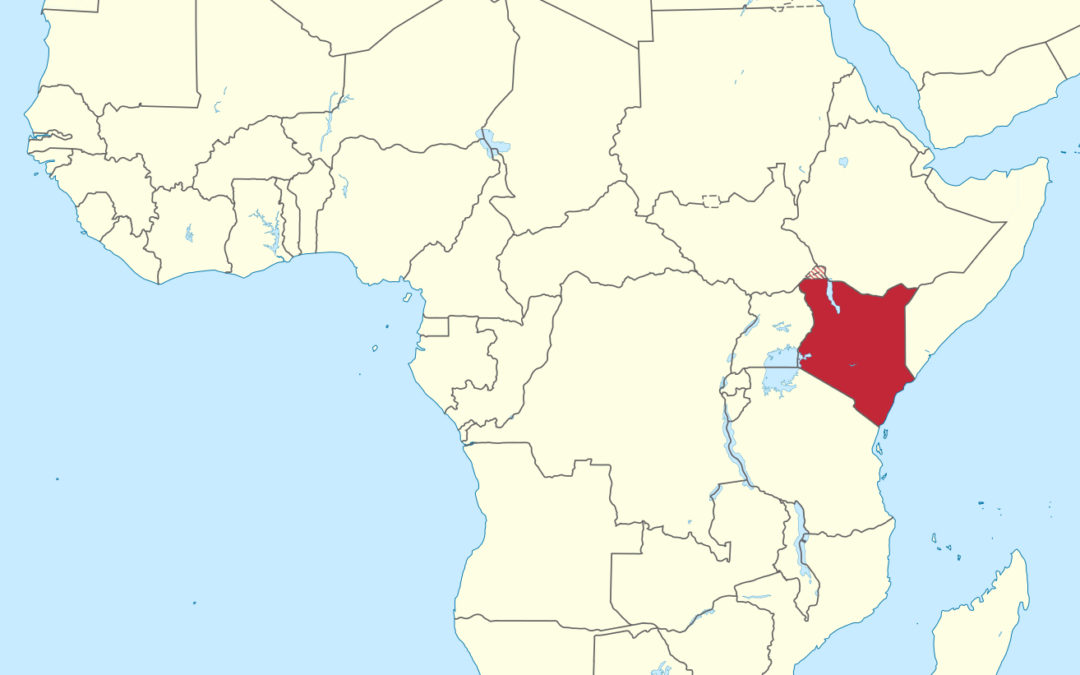
by Fredrick Nzwili, RNS | Sep 23, 2021 | Headline News |
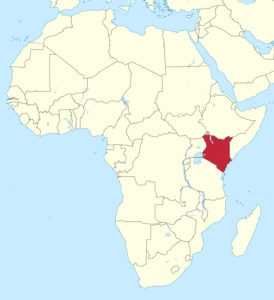
Kenya, in red, located in eastern Africa. Map courtesy of Creative Commons
NAIROBI, Kenya (RNS) — Some churches in Kenya have barred politicians from addressing their congregations, saying campaigning during services disrespects the sanctity of worship.
The national Anglican, Presbyterian and Roman Catholic churches have all issued bans, as many of the politicians begin early stumping for next year’s general elections. The Methodist Church, however, is keeping the church doors open for all.
The Rev. Joseph Ntombura, presiding bishop of the Methodist Church in Kenya, has said his church is not dissenting from the effort but is taking a different approach. The bishop said shutting the doors to politicians would mean discriminating against some of its members.
“The church is for all people,” Ntombura told Religion News Service in a telephone interview. “Human beings are political, so there is nothing wrong with inviting the politicians in church.”
According to the bishop, congregations need to hear the views of politicians on issues of national interest, such as the sharing of resources. In the past, Ntombura said, the church has invited other experts to speak to congregations on important matters, and politicians are no different.
“Some of the politicians are our pastors,” said Ntombura.
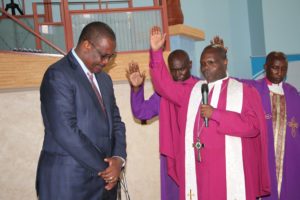
The Rev. Joseph Ntombura, with microphone, presiding Bishop of the Methodist Church in Kenya, prays over former Nairobi Governor Evans Kidero, left, in Nov. 2015. RNS photo by Fredrick Nzwili
Kenya is about 85% Christian. About 33% of that group are Protestants and 20.6% are Catholic. The rest belong to evangelical, Pentecostal and African denominations. Muslims make up 11% of the population.
In issuing the bans on politicking in church, denominations have said they feared that church services would become campaign rallies and that candidates would use language bordering on hate speech in an attempt to win votes or sway the views of congregations. In the past, politicians hijacked church services to sell their agendas or criticize their opponents. Some have appeared in the churches with huge sums of money as offerings or as funds for church projects.
The no-politicking effort gained momentum this month when Archbishop Jackson Ole Sapit, the Anglican primate of Kenya, announced his church’s ban.
“Everyone is welcome in the churches, but we have the pews and the pulpit,” said Ole Sapit on Sept. 12, during the ordination of Kenya’s first Anglican woman bishop. “The pulpit is for the clergy and the pews for everyone who comes to worship.”
On Sept. 15, the Roman Catholic bishops said their places of worship and liturgy were sacred and were not political arenas. They urged politicians to attend Mass just like any other worshippers.
Analysts say the churches are seeking to reclaim their position as “honest arbitrators” in a country where elections often generate violent conflicts.
The most deadly came in December 2007 and January 2008, when two months of ethnic fighting left at least 1,000 people dead and more than 600,000 displaced from their homes. Among them, 30 people, mainly ethnic Kikuyu, Kenya’s largest tribe, were burnt alive in an Assemblies of God church in Kiambaa Village in Eldoret.
Henry Njagi, program and information manager at the National Council of Churches of Kenya, said resistance to church guidelines on political speech risks a repeat of the events of 2008.
“When things went wrong, they turned around and accused the church of being silent and abandoning Kenyans,” said Njagi. “So right now is a call on political actors, aspirants and other stakeholders to listen to the church … and stop toxic politicking.”
Though the politicians have not been as present at mosques, Muslim leaders say they are supporting the ban on toxic politicking in the churches.
“I support the Christian leaders. Such a ban is long overdue,” said Sheikh Hassan Ole Naado, national chairman of the Supreme Council of Kenya Muslims.
He added that Muslims were not facing the issue at the moment.
“When you go to a place of worship, you know what you are supposed to do. They are taking advantage of people who are gathered for worship. It should not happen in the first place,” said Ole Naado.
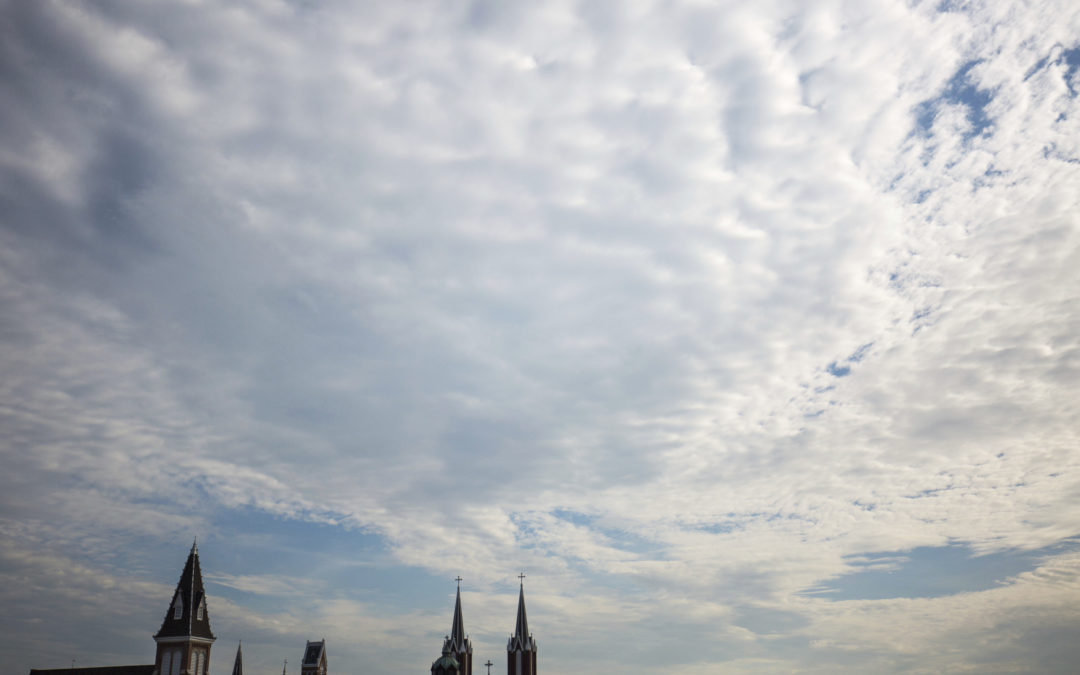
by Luis Andres Henao | May 25, 2021 | Headline News |

This Sunday, July 10, 2016 photo shows the First Baptist Church, left, the First Baptist Church of Christ, center, and Saint Joseph’s Catholic Church in Macon, Ga. About 170 years ago, the two Baptist churches were one congregation, albeit a church of masters and slaves. Then the fight over abolition and slavery started tearing badly at religious groups and moving the country toward Civil War. The Macon church, like many others at the time, decided it was time to separate by race. (AP Photo/Branden Camp)
The faith community should guide the way on reparations for America’s history of slavery and racial discrimination and help the nation’s process of reconciliation and healing, religious leaders said during a panel held to discuss the issue.
U.S. religious groups have seen widespread interest in reparations, especially among Protestant churches that were active in the era of slavery. Many are starting or now considering how to make amends through financial investments and long-term programs benefiting Black Americans.
“The faith community not only can lead but should lead, and is in a unique position to lead,” the Rev. Iva E. Carruthers, general secretary of the Samuel DeWitt Proctor Conference, said during the Wednesday panel organized by The Associated Press, The Religion News Service and The Conversation.
The Episcopal Diocese of Maryland voted last year to create a $1 million reparations fund, likely to finance programs supporting Black students, nursing home residents, small-business owners and others. The vote followed years of research into how the diocese had benefited from racial inequality and slavery.
“If not the faith community, who? And if not now, when?” said the Right Rev. Eugene Sutton, the first Black cleric to hold the post of bishop of the diocese.
“Perhaps one of the reasons why so many in our society are saying, ‘Well, I can be spiritual, but I don’t have to belong to any religious organization,’ is because religious faith communities have failed to live up to their scriptures and to our words,” Sutton said. “We need to put our money where our mouth is. And reparations is one way to do that.”
Panelists were asked what they tell those who oppose reparations on the grounds that they’re not guilty of slaveholding or racism and shouldn’t be asked to pay for those crimes. Sutton said it’s not about guilt but a responsibility to repair the damage caused.
“Reparations is not a transfer of money from white people to Black people,” Sutton said. “It’s rather what this generation will do to correct the wrongs that previous generations have started.”
University of South Carolina history professor Nicole Maskiell, who has worked with congregations involved in reparations initiatives, praised faith communities for being first and leading by example.
“That takes courage,” she said. “It takes commitment, and it also takes a willingness to tell the truth.”
The Minnesota Council of Churches has cited a host of injustices — from mid-19th century atrocities against Native Americans to police killings of Black people — in launching a first-of-its kind “truth and reparations” initiative.
The initiative engages a diverse collection of 25 Christian member denominations, including some that are predominantly Black, and will model some of its efforts on South Africa’s post-apartheid Truth and Reconciliation Commission. It is based in Minneapolis, where the police killing of George Floyd last May sparked global protests over racial injustice.
“When I was growing up, white supremacy was a problem of the South. … Within the last five years, just here in Minneapolis, we’ve had the killing of Jamar Clark, Philando Castile, George Floyd, Daunte Wright,” said the Rev. Jim Bear Jacobs, the council’s director of racial justice. “All of this within 7 miles of each other, each one of those young men all at the hands of police, all unwarranted killings.”
“How did we, as a city of Minneapolis, how did we get to this point? And the only answer one can arrive at is white supremacy.”
Jacobs, who belongs to a Wisconsin-based Mohican tribe but was born in Minnesota, said the initiative seeks to address social justice concerns of African Americans and Native Americans in a unified way: “We are so much stronger together than we are doing our justice work in silos.”
Panelists said they’re hopeful that the latest attempts to address reparations will turn into meaningful action because the country is in the midst of a historic reckoning on racism, because young people are engaged and seeking justice and because faith communities have come together to demonstrate.
“Every night over the roar of the cries for justice, you could hear the indigenous drumbeat. … We’re there,” Jacobs said. “I have linked arm-in-arm with rabbis and imams and bishops and pastors.”
Rep. Sheila Jackson Lee, D-Texas, who has sponsored a bill that would create a commission to study slavery and discrimination in the United States from 1619 to the present, said she hopes it will be passed by the House in late June.
The commission would also recommend ways to educate Americans about its findings and appropriate remedies, including how the government would offer a formal apology and what form of compensation should be awarded.
Support from the faith community, she said, is crucial: “It can help people, Americans, grapple with, understand and feel comfortable with doing the right thing.”
“We’ve come this far by faith, our beliefs, whether or not we’re reading from the Quran or the Torah, we’re reading from the Bible or any other faith book somewhere in there about love and charity and somewhere in there about restoration. I know there’s something in there about redemption,” Jackson Lee said. “That’s what America has to do.”
__
Associated Press writers David Crary and Kevin Freking contributed to this report.
___
Associated Press religion coverage receives support from the Lilly Endowment through The Conversation U.S. The AP is solely responsible for this content.
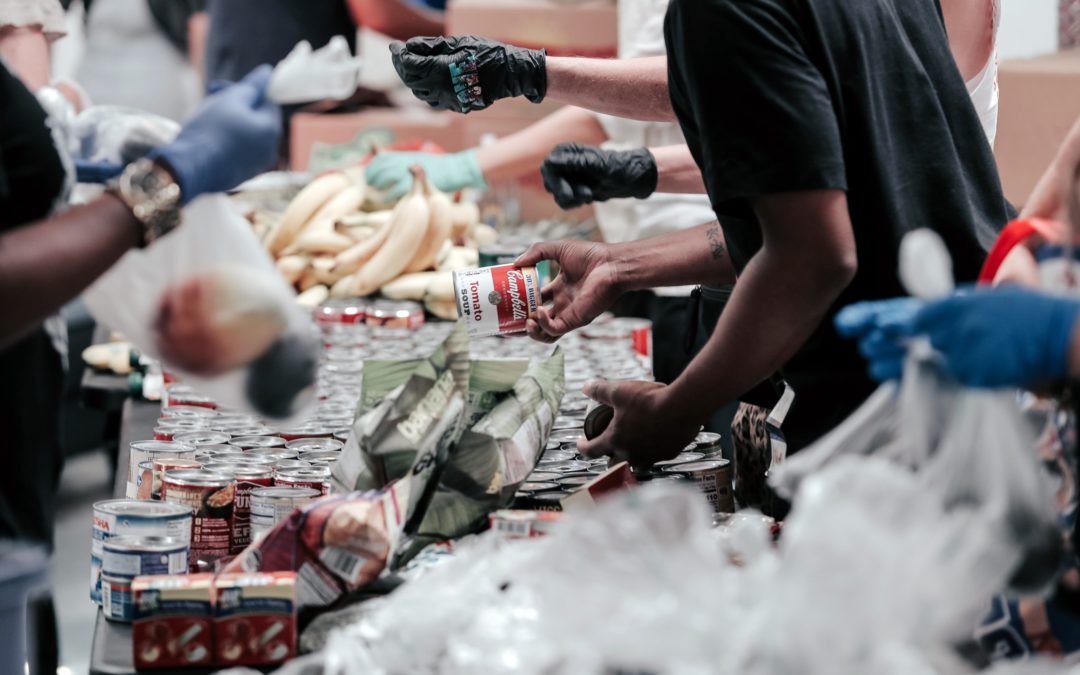
by Michael Wear, RNS | May 11, 2021 | Commentary, Headline News |
 (RNS) — In a period of significant pressure on our democracy, our health and our overall well-being as a people, faith has provided a hidden infrastructure that has held America together. We miss out on much good when we do not recognize the role of faith and religious institutions in our communities.
(RNS) — In a period of significant pressure on our democracy, our health and our overall well-being as a people, faith has provided a hidden infrastructure that has held America together. We miss out on much good when we do not recognize the role of faith and religious institutions in our communities.
Last month, the Bridgespan Group released a report confirming what many of us already knew: While faith-inspired organizations, congregations and individuals make up a large percentage of America’s civic and social landscape — especially when it comes to providing aid to low-income people and those on the margins — they are significantly underrepresented and overlooked by philanthropic institutions who fund in these areas. Although faith is often in the headlines as a subject of political intrigue and a tool of partisan warfare, in the lives of millions of Americans, faith is felt closer to home, helping them to survive and make it week to week, day to day.
If you’re not familiar with the basic state of play, the findings of the Bridgespan Group might strike you as something more problematic than simply a missed opportunity. The report finds that “faith-inspired organizations account for 40 percent of social safety net spending across a sample of six cities, which vary in size and demographics. Yet, while some individual philanthropists and community foundations have recognized faith-inspired organizations as platforms for impact, that perspective has not translated into funding from the largest institutional philanthropies — particularly those seeking to address the effects of poverty and injustice.”
The report quotes Kashif Shaikh, co-founder and executive director of the Pillars Fund, a grantmaking organization that invests in American Muslim organizations, who rightly points out: “Secularism is the dominant narrative in the U.S., but often less so in vulnerable communities, in my experience. It’s a disservice to not even acknowledge it.”
Indeed, while it is certainly within the rights of philanthropic institutions to “not do religion,” such an approach undermines any meaningful, holistic commitment to community or place-based philanthropy in much of this country and in many places around the world. At best, a categorical rejection of religious engagement among institutions working in significantly religious communities amounts to an acknowledgment of an organizational deficiency. At worst, it adds up to a willful act of disruption and disrespect for the values, beliefs and culture of the communities that are “served.”
The problem is not just in philanthropy. In politics and public life, faith is often viewed as a sword or a shield for one’s own agenda. Religious communities are too rarely considered on their own terms, categorized instead as political foe or ally. This dynamic contributed to an unfortunate and harmful tenor of conflict between some governments and religious communities as we sought to mitigate COVID-19. These conflicts emerged, in part, because many elected officials viewed religious communities as a problem to solve rather than a potential partner. Politicians need to start viewing faith communities as not just sources of votes, but sources of wisdom and expertise.
Philanthropy for Active Civic Engagement (PACE) detected a lack of understanding for how faith and civic health are tied together, and in particular, how faith communities are helping people build relationships and work together across difference. In 2019, they launched a funding and learning initiative, Faith In/And Democracy, to support faith-inspired organizations and efforts that are helping to hold our communities and our democracy together.

As an adviser to this program, I have been able to see the tireless, often thankless, work grantees of the program have advanced. We set out to determine if there was a distinct field of faith organizations and actors supporting our civic life, and our efforts have been met with a resounding “yes.” In its pilot year, over 130 qualified organizations applied to the program, and five were selected to participate in a robust learning community that included a range of advisers as well as philanthropic leaders committed to this work. Together, we grappled with what COVID-19 might mean for our grantees’ work, and we saw up close how they discovered creative ways to persist in their mission despite numerous roadblocks. During an election year when some sought to stir up religious resentment and conflict, our grantees were working to strengthen our democracy and build bridges of faith between disparate communities.
Through the crises of this year and my experiences working in the White House under President Obama, I have come to rely on the fact that if there is a crisis or challenge in the news, there are people of faith at work to address it for the common good. Faith is always at work.
As we turn our focus from lockdowns to vaccinations, public officials are turning to religious communities for support. In recent weeks, Dr. Francis Collins and Dr. Anthony Fauci participated in a service with D.C.-area clergy focused on the vaccine. Dr. Fauci has referred to the imperative to get adults vaccinated as a “‘love thy neighbor’ opportunity.” After relative dormancy during the Trump years, President Biden has reestablished and reinvigorated the White House Office of Faith-based and Neighborhood Partnerships, which should ensure the federal government is able to effectively partner with the faith community to keep the national response to COVID-19 on track.
If respected, valued and included, people of faith and religious institutions can be partners on so many of the issues at the top of the national agenda. For example, the Biden administration should not merely welcome the support of people of faith for the anti-poverty provisions in the American Rescue Plan, but rather, invite faith leaders to champion the provisions, to claim them as a harbinger of a new national commitment to better care for the “least of these.”
Likewise, we cannot have a conversation about strengthening our democracy without recognizing the role of faith as a molder of civic character and a shaper of civic consciousness. Faith communities’ value to our democracy does not only show up for “Souls to the Polls,” but in the countless ways in which faith beckons Americans outside of themselves and toward their neighbors. In many communities, congregations serve as civic incubators, forums for strengthening muscles of service, negotiation and love.
Philanthropy, governments and other sectors should never instrumentalize faith, nor impose their values on faith communities. The point is not that faith communities should be viewed as potential avenues for advancing someone else’s agenda — rather, that so much of what we struggle to do and be is already attended to by the resources inherent in many religious communities.
Nothing does what faith does the way faith does it. We’re going to need it in the days ahead, just as it has been here — quietly, at times — all along.
(Michael Wear is founder of Public Square Strategies, LLC, and an adviser to PACE’s Faith In/And Democracy initiative. Heserved in the White House as part of President Barack Obama’s faith-based initiative. The views expressed in this commentary do not necessarily reflect those of Religion News Service.)
by Jelani Greenidge, Urban Faith Contributing Writer | Nov 6, 2020 | Entertainment |
 It used to be that you had to be stuck in bumper-to-bumper traffic to be exposed to sarcastic, misleading, and — fine, I’ll admit it — occasionally entertaining slogans about politics and spirituality.
It used to be that you had to be stuck in bumper-to-bumper traffic to be exposed to sarcastic, misleading, and — fine, I’ll admit it — occasionally entertaining slogans about politics and spirituality.
No longer is this the case.
If you use Facebook with any kind of regularity, you’ve probably witnessed photo memes popping up like dandelions. And you may have liked them. You might have shared them. You might have even created a few. But I implore you — please stop. You’re making it hard for real communication to take place on Facebook, which is one of the few places where people with radically different worldviews can engage in honest dialogue.
Don’t believe me? I offer several reasons, with examples:
Reason No. 1: They’re often inaccurate or misleading.

Exhibit A in our proceedings is this gem above rebuking Christians for focusing on the wrong things. Now the fact is, the underlying truth behind this is something that I believe in strongly — Christians should be known more for how we help the disenfranchised than for what political stands we take. But the actual statement is just not true. Plenty of Christians line up at food banks and homeless shelters all the time — so much so, in fact, that these days it fails to even qualify as news. But you’d never know it from this meme photo, which relies more on stereotypes than actual data.
And this image is just the tip of the iceberg. With the next big story involving a church or a Christian leader, there’ll be plenty more.
And even the ones that aren’t snarky in tone can be disingenuous. If they include any kind of statistical graph, for instance, they’re bound to manipulate or distort the truth in some way. After all, there’s a reason why Mark Twain referred to statistics as the worst form of lying. The best of these are usually large and thorough enough that they require full-screen viewing to accommodate all the details. But even these should be taken with a grain of salt.
And don’t even get me started on the photos-with-long-stories-as-captions, which are often just the same recycled urban legends from email forwards.
Reason No. 2: They exist primarily to amuse or incite people who already think like you do.

Let’s be honest. People don’t encounter these photos and say, “Wow, perhaps I’ve been wrong all these years, and my long-held political and/or religious beliefs are actually dangerous and wrong.”
It never happens because these aren’t designed to engage people who hold different views. Rather, their purpose is the same as much of the partisan-slanted media we see today — to reinforce your views and help you feel better about yourself for believing that way.
Now, I’m all for exercising free speech — but images have power. And as we know from Spider-Man’s Uncle Ben, with great power comes great responsibility. And if this were only a political issue, I might not be as concerned. But in today’s political climate, where being a Christian is still associated with being Republican, these photos are making it harder for unbelievers to see the truth of the gospel because of all the political baggage.
I believe that everyone, Christian or not, has a right to participate in the political process. But Paul told the church in Galatia to avoid letting their freedom become an excuse to indulge in their sinful nature. For many of us, sharing these photos is a way of sticking it to the people who we feel are “the problem.”
As citizens of a global community, this is wrong.
Reason No. 3: If not misleading or divisive, they’re often so generic as to be meaningless.

Because “if at first you don’t succeed” at motivating your friends, maybe there’s something missing.
And that something is context. Many of these inspirational quotes and images, if they were on my refrigerator, I might find really moving. But the thing is, they would only be there if I put them there. People self-select these things. You can’t pass out inspirational nuggets like candy and expect them to be effective. One person’s inspirational quote is another person’s cheesy platitude.
And finally…
Reason No. 4: They make it harder to enjoy actual photos taken by your actual Facebook friends.
No disrespect to George Takei, the Japanese-American Star Trek alumnus whose posts get shared like crazy by his millions of Facebook fans, but he’s not my Facebook friend.
I know that in today’s relational economy Facebook friendships are slightly more meaningful than people with whom you make eye contact in elevators … but still. With so many people in my Facebook feed, I find much more meaning and significance in the large and small details that my friends post about their lives. You know, babies, vacations, meals, costumes, graduations, etc. So by constantly sharing these photo memes, you’re cluttering your feed with stuff I’m not interested in.
Because that’s the point of Facebook, right? To make connections and enjoy relationships. So if you want to be someone who builds relationships across the cultural divide, do us all a favor and stop posting these photos.
by Jelani Greenidge, Urban Faith Contributing Writer | Nov 4, 2020 | Headline News |
 It used to be that you had to be stuck in bumper-to-bumper traffic to be exposed to sarcastic, misleading, and — fine, I’ll admit it — occasionally entertaining slogans about politics and spirituality.
It used to be that you had to be stuck in bumper-to-bumper traffic to be exposed to sarcastic, misleading, and — fine, I’ll admit it — occasionally entertaining slogans about politics and spirituality.
No longer is this the case.
If you use Facebook with any kind of regularity, you’ve probably witnessed photo memes popping up like dandelions. And you may have liked them. You might have shared them. You might have even created a few. But I implore you — please stop. You’re making it hard for real communication to take place on Facebook, which is one of the few places where people with radically different worldviews can engage in honest dialogue.
Don’t believe me? I offer several reasons, with examples:
Reason No. 1: They’re often inaccurate or misleading.

Exhibit A in our proceedings is this gem above rebuking Christians for focusing on the wrong things. Now the fact is, the underlying truth behind this is something that I believe in strongly — Christians should be known more for how we help the disenfranchised than for what political stands we take. But the actual statement is just not true. Plenty of Christians line up at food banks and homeless shelters all the time — so much so, in fact, that these days it fails to even qualify as news. But you’d never know it from this meme photo, which relies more on stereotypes than actual data.
And this image is just the tip of the iceberg. With the next big story involving a church or a Christian leader, there’ll be plenty more.
And even the ones that aren’t snarky in tone can be disingenuous. If they include any kind of statistical graph, for instance, they’re bound to manipulate or distort the truth in some way. After all, there’s a reason why Mark Twain referred to statistics as the worst form of lying. The best of these are usually large and thorough enough that they require full-screen viewing to accommodate all the details. But even these should be taken with a grain of salt.
And don’t even get me started on the photos-with-long-stories-as-captions, which are often just the same recycled urban legends from email forwards.
Reason No. 2: They exist primarily to amuse or incite people who already think like you do.

Let’s be honest. People don’t encounter these photos and say, “Wow, perhaps I’ve been wrong all these years, and my long-held political and/or religious beliefs are actually dangerous and wrong.”
It never happens because these aren’t designed to engage people who hold different views. Rather, their purpose is the same as much of the partisan-slanted media we see today — to reinforce your views and help you feel better about yourself for believing that way.
Now, I’m all for exercising free speech — but images have power. And as we know from Spider-Man’s Uncle Ben, with great power comes great responsibility. And if this were only a political issue, I might not be as concerned. But in today’s political climate, where being a Christian is still associated with being Republican, these photos are making it harder for unbelievers to see the truth of the gospel because of all the political baggage.
I believe that everyone, Christian or not, has a right to participate in the political process. But Paul told the church in Galatia to avoid letting their freedom become an excuse to indulge in their sinful nature. For many of us, sharing these photos is a way of sticking it to the people who we feel are “the problem.”
As citizens of a global community, this is wrong.
Reason No. 3: If not misleading or divisive, they’re often so generic as to be meaningless.

Because “if at first you don’t succeed” at motivating your friends, maybe there’s something missing.
And that something is context. Many of these inspirational quotes and images, if they were on my refrigerator, I might find really moving. But the thing is, they would only be there if I put them there. People self-select these things. You can’t pass out inspirational nuggets like candy and expect them to be effective. One person’s inspirational quote is another person’s cheesy platitude.
And finally…
Reason No. 4: They make it harder to enjoy actual photos taken by your actual Facebook friends.
No disrespect to George Takei, the Japanese-American Star Trek alumnus whose posts get shared like crazy by his millions of Facebook fans, but he’s not my Facebook friend.
I know that in today’s relational economy Facebook friendships are slightly more meaningful than people with whom you make eye contact in elevators … but still. With so many people in my Facebook feed, I find much more meaning and significance in the large and small details that my friends post about their lives. You know, babies, vacations, meals, costumes, graduations, etc. So by constantly sharing these photo memes, you’re cluttering your feed with stuff I’m not interested in.
Because that’s the point of Facebook, right? To make connections and enjoy relationships. So if you want to be someone who builds relationships across the cultural divide, do us all a favor and stop posting these photos.







 (RNS) — In a period of significant pressure on our democracy, our health and our overall well-being as a people, faith has provided a hidden infrastructure that has held America together. We miss out on much good when we do not recognize the role of faith and religious institutions in our communities.
(RNS) — In a period of significant pressure on our democracy, our health and our overall well-being as a people, faith has provided a hidden infrastructure that has held America together. We miss out on much good when we do not recognize the role of faith and religious institutions in our communities.
 It used to be that you had to be stuck in bumper-to-bumper traffic to be exposed to sarcastic, misleading, and — fine, I’ll admit it — occasionally entertaining slogans about politics and spirituality.
It used to be that you had to be stuck in bumper-to-bumper traffic to be exposed to sarcastic, misleading, and — fine, I’ll admit it — occasionally entertaining slogans about politics and spirituality.

